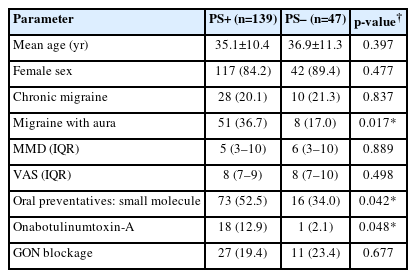Erratum to “Premonitory Symptoms in Migraine: Implications for Disease Burden and Cognitive Impairment, with Some Promising Answers”
Article information
Headache Pain Res. 2025;26(3):232-232
1Department of Neurology, Mersin University School of Medicine, Mersin, Turkey
2Department of Biostatistics, Mersin University School of Medicine, Mersin, Turkey
Correspondence: Aynur Özge, M.D. Department of Neurology, Mersin University School of Medicine, Çiftlikköy Mah., MEÜ Çiftlikköy Kampüsü, 33110 Yenişehir/Mersin, Turkey Tel: +90-324-2410000 (1902), Fax: +90-3242410000-1907, E-mail:
aozge@mersin.edu.tr
This is a correction to an already published paper (Headache Pain Res 2025;26(2):130-141; https://doi.org/10.62087/hpr.2024.0031). We found errors in the IQR values in and . Appropriately adjusted are as below.
Comparison of demographic features between the PS+ and PS– groups
Comparison of the PS+ and PS– groups in terms of migraine trigger factors
This error does not change the text and the conclusions of our paper. We apologize for the unintentional mistake and appreciate the opportunity to correct and clarify the issue.
Article information Continued
© 2025 The Korean Headache Society
Table 1.
Comparison of demographic features between the PS+ and PS– groups
| Parameter |
PS+ (n=139) |
PS– (n=47) |
p-value†
|
| Mean age (yr) |
35.1±10.4 |
36.9±11.3 |
0.397 |
| Female sex |
117 (84.2) |
42 (89.4) |
0.477 |
| Chronic migraine |
28 (20.1) |
10 (21.3) |
0.837 |
| Migraine with aura |
51 (36.7) |
8 (17.0) |
0.017* |
| MMD (IQR) |
5 (3–10) |
6 (3–10) |
0.889 |
| VAS (IQR) |
8 (7–9) |
8 (7–10) |
0.498 |
| Oral preventatives: small molecule |
73 (52.5) |
16 (34.0) |
0.042* |
| Onabotulinumtoxin-A |
18 (12.9) |
1 (2.1) |
0.048* |
| GON blockage |
27 (19.4) |
11 (23.4) |
0.677 |
Table 3.
Comparison of the PS+ and PS– groups in terms of migraine trigger factors
|
PS+ (n=139) |
PS– (n=47) |
p-value†
|
| MIDAS (IQR) |
26 (14–40) |
16 (10–33.5) |
0.05 |
| Mig-SCOG (IQR) |
10 (7–14) |
7 (4–10) |
<0.001* |
| EUROHIS-8 (IQR) |
3.12 (2.75–3.62) |
3.62 (3.12–4.00) |
<0.001* |


